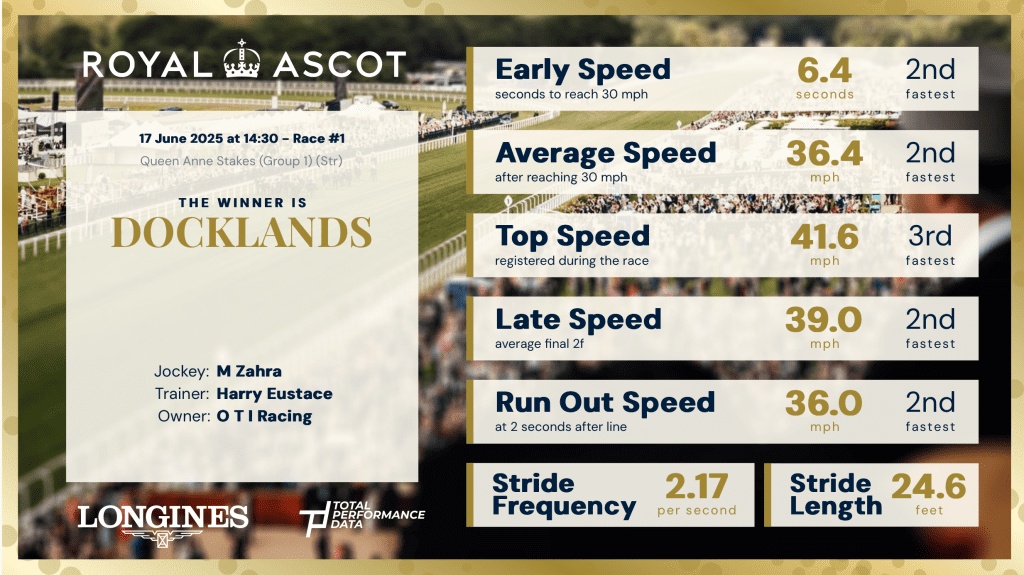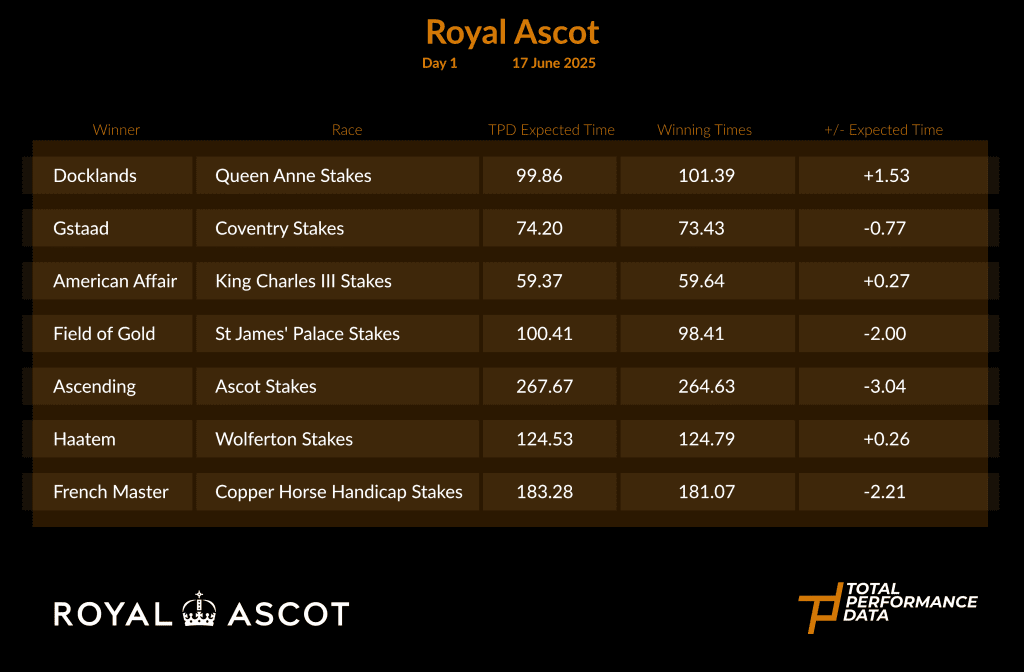

Let’s start with a brief word about the Queen Anne. Docklands has an outstanding record at Ascot, but there was still a slight sense of an anti-climax when he was called the winner in the tight photo finish with Rosallion. A winning time of 1:41.39 was 1.53s slower than the TPD expected time and the fact that the entire field took longer than 13-seconds to run the 2nd furlong is testament to the lack of pace. For some context, in the 2024 renewal won by Charyn, the entire field ran sub 12-seconds for the same furlong. A finishing speed of 110.83% confirms the initial thoughts that this race developed into a sprint and Mark Zahra made a race winning move by kicking for home with 2-furlongs to run, with Docklands producing an 11.22s 7th furlong, the best in the race. Was Rosallion unlucky? Almost certainly, he was faster than the winner in the 6th and final furlongs, but in a slowly run race the fractions and room for error get smaller and Mark Zahra was the one to judge things correctly on this occasion.
The advantage that Zahra had came from the horses around him. Racing towards the far side, he had the good fortune that the only horse on his outside, Diego Velaquez, wasn’t travelling and that allowed his mount to stretch, reaching a race peak average stride length of 7.97m in the 6th furlong to move to the front. At an average of 7.49m throughout the race, Docklands had the longest stride in the field and whilst Rosallion did well to get so close, we should add that the winner had a faster run-out speed at 35.97 mph.
We don’t need data to tell us that Notable Speech was an unlucky loser. He finished 4th, but he simply didn’t get the racing room in a contest that developed into a sprint. His average stride frequency didn’t peak until the final furlong when it reached 2.56 per second and he was the only horse and that made him the only horse to increase his stride frequency figure in the closing stages. He is undoubtedly a horse for next time. However, less obvious was the unfortunate Lake Forest. He was ridden towards the rear of the field, perhaps understandably given that he is yet to win over a mile, but as the pace lifts, he is making headway. The issue is, that he tracks Quddwah and then Carl Spackler, both of which were slowing down at the point he was tracking them. To his credit, he ran on through the line and recorded the fastest run-out speed in the field at 36.04 mph. I need to add the point that this slowly run race will not confirm him as capable of staying this mile trip, but he has certainly run better than the bare result.
Although he was sent off at 100/1, this was a career best effort from Cairo, who came from last to 3rd to reward his connections’ faith. At 42.10 mph, he recorded the fastest top speed figure in the field and whilst he was staying on passing beaten horses in the closing stages, he did run that fastest 6th furlong in the field at 11.11s and found only the first 2 quicker than him over the final quarter of a mile. He has only won 3 of his 21 starts and at this stage, he is unlikely to suddenly find another 10 lbs of improvement, but he was 3rd in an Irish 2,000 Guineas and has hit the frame in the Al Rashidiya and the Dubai Millenium Stakes in Dubai, so this performance wasn’t entirely out of character. With a strike rate of 14%, he isn’t a certainty to back this up, but as he showed in this race, he is capable of paying his way at this level.
Now let’s move on to the feature race, the St James’ Palace stakes. A winning time of 1:38.41 was 2-seconds faster than the TPD Expected time under these conditions and when we consider that the runner-up was over a second below the expected time, despite the fact that he was beaten by 3.5 lengths, it can only serve to upgrade the remarkable performance from Field of Gold. Whilst both Rosallion and Poetic Flare have run faster times in the last 10-years, the comparison with the other races on the card would suggest that the ground was Good to Firm, but not as fast as it could have been. Given that those horses employed with pacemaking duties were only able to get as far as the 2-furlong pole, we can surely give a performance upgrade to Field of Gold for the way that he has pulled clear in the closing stages.


The above graphic shows the winning times for Tuesday’s races and comparisons with the expected time from the TPD database. As we have already discussed, this was a slowly run Queen Anne Stakes and so that doesn’t work as a great comparison, but we can learn from the other races. It’s not a particular surprise to see Field of Gold with one of the best time figures on the day, but even his time would suggest that the ground is no worse than the Good to Firm advertised. Every race is within 2% of the expected time figure and it will be interesting to compare these times with those later in the week, especially with a dry, hot forecast likely to have an effect even with watering.